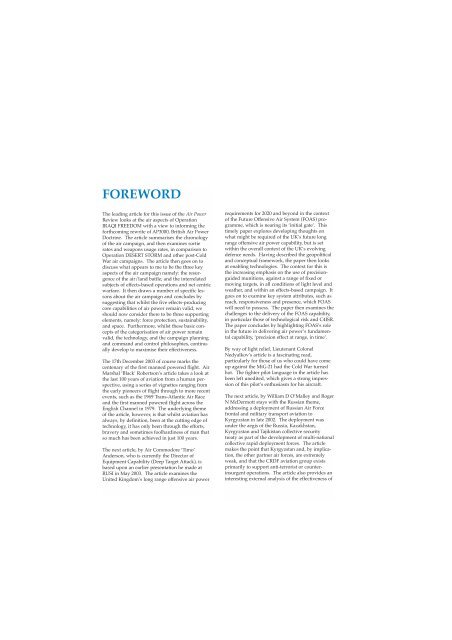Volume 6 No 4 - Royal Air Force Centre for Air Power Studies
Volume 6 No 4 - Royal Air Force Centre for Air Power Studies
Volume 6 No 4 - Royal Air Force Centre for Air Power Studies
Create successful ePaper yourself
Turn your PDF publications into a flip-book with our unique Google optimized e-Paper software.
FOREWORD<br />
The leading article <strong>for</strong> this issue of the <strong>Air</strong> <strong>Power</strong><br />
Review looks at the air aspects of Operation<br />
IRAQI FREEDOM with a view to in<strong>for</strong>ming the<br />
<strong>for</strong>thcoming rewrite of AP3000, British <strong>Air</strong> <strong>Power</strong><br />
Doctrine. The article summarises the chronology<br />
of the air campaign, and then examines sortie<br />
rates and weapons usage rates, in comparison to<br />
Operation DESERT STORM and other post-Cold<br />
War air campaigns. The article then goes on to<br />
discuss what appears to me to be the three key<br />
aspects of the air campaign namely: the resurgence<br />
of the air/land battle; and the interrelated<br />
subjects of effects-based operations and net centric<br />
warfare. It then draws a number of specific lessons<br />
about the air campaign and concludes by<br />
suggesting that whilst the five effects-producing<br />
core capabilities of air power remain valid, we<br />
should now consider there to be three supporting<br />
elements, namely: <strong>for</strong>ce protection, sustainability,<br />
and space. Furthermore, whilst these basic concepts<br />
of the categorisation of air power remain<br />
valid, the technology, and the campaign planning<br />
and command and control philosophies, continually<br />
develop to maximise their effectiveness.<br />
The 17th December 2003 of course marks the<br />
centenary of the first manned powered flight. <strong>Air</strong><br />
Marshal ‘Black’ Robertson’s article takes a look at<br />
the last 100 years of aviation from a human perspective,<br />
using a series of vignettes ranging from<br />
the early pioneers of flight through to more recent<br />
events, such as the 1969 Trans-Atlantic <strong>Air</strong> Race<br />
and the first manned powered flight across the<br />
English Channel in 1979. The underlying theme<br />
of the article, however, is that whilst aviation has<br />
always, by definition, been at the cutting edge of<br />
technology, it has only been through the ef<strong>for</strong>ts,<br />
bravery and sometimes foolhardiness of man that<br />
so much has been achieved in just 100 years.<br />
The next article, by <strong>Air</strong> Commodore ‘Timo’<br />
Anderson, who is currently the Director of<br />
Equipment Capability (Deep Target Attack), is<br />
based upon an earlier presentation he made at<br />
RUSI in May 2003. The article examines the<br />
United Kingdom’s long range offensive air power<br />
requirements <strong>for</strong> 2020 and beyond in the context<br />
of the Future Offensive <strong>Air</strong> System (FOAS) programme,<br />
which is nearing its ‘initial gate’. This<br />
timely paper explores developing thoughts on<br />
what might be required of the UK’s future long<br />
range offensive air power capability, but is set<br />
within the overall context of the UK’s evolving<br />
defence needs. Having described the geopolitical<br />
and conceptual framework, the paper then looks<br />
at enabling technologies. The context <strong>for</strong> this is<br />
the increasing emphasis on the use of precisionguided<br />
munitions, against a range of fixed or<br />
moving targets, in all conditions of light level and<br />
weather, and within an effects-based campaign. It<br />
goes on to examine key system attributes, such as<br />
reach, responsiveness and presence, which FOAS<br />
will need to possess. The paper then examines the<br />
challenges to the delivery of the FOAS capability,<br />
in particular those of technological risk and C4ISR.<br />
The paper concludes by highlighting FOAS’s role<br />
in the future in delivering air power’s fundamental<br />
capability, ‘precision effect at range, in time’.<br />
By way of light relief, Lieutenant Colonel<br />
Nedyalkov’s article is a fascinating read,<br />
particularly <strong>for</strong> those of us who could have come<br />
up against the MiG-21 had the Cold War turned<br />
hot. The fighter pilot language in the article has<br />
been left unedited, which gives a strong impression<br />
of this pilot’s enthusiasm <strong>for</strong> his aircraft.<br />
The next article, by William D O’Malley and Roger<br />
N McDermott stays with the Russian theme,<br />
addressing a deployment of Russian <strong>Air</strong> <strong>Force</strong><br />
frontal and military transport aviation to<br />
Kyrgyzstan in late 2002. The deployment was<br />
under the aegis of the Russia, Kazakhstan,<br />
Kyrgyzstan and Tajikistan collective security<br />
treaty as part of the development of multi-national<br />
collective rapid deployment <strong>for</strong>ces. The article<br />
makes the point that Kyrgyzstan and, by implication,<br />
the other partner air <strong>for</strong>ces, are extremely<br />
weak, and that the CRDF aviation group exists<br />
primarily to support anti-terrorist or counterinsurgent<br />
operations. The article also provides an<br />
interesting external analysis of the effectiveness of
















